Microsoft Power Platform Developer 온라인 연습
최종 업데이트 시간: 2025년11월17일
당신은 온라인 연습 문제를 통해 Microsoft PL-400 시험지식에 대해 자신이 어떻게 알고 있는지 파악한 후 시험 참가 신청 여부를 결정할 수 있다.
시험을 100% 합격하고 시험 준비 시간을 35% 절약하기를 바라며 PL-400 덤프 (최신 실제 시험 문제)를 사용 선택하여 현재 최신 61개의 시험 문제와 답을 포함하십시오.
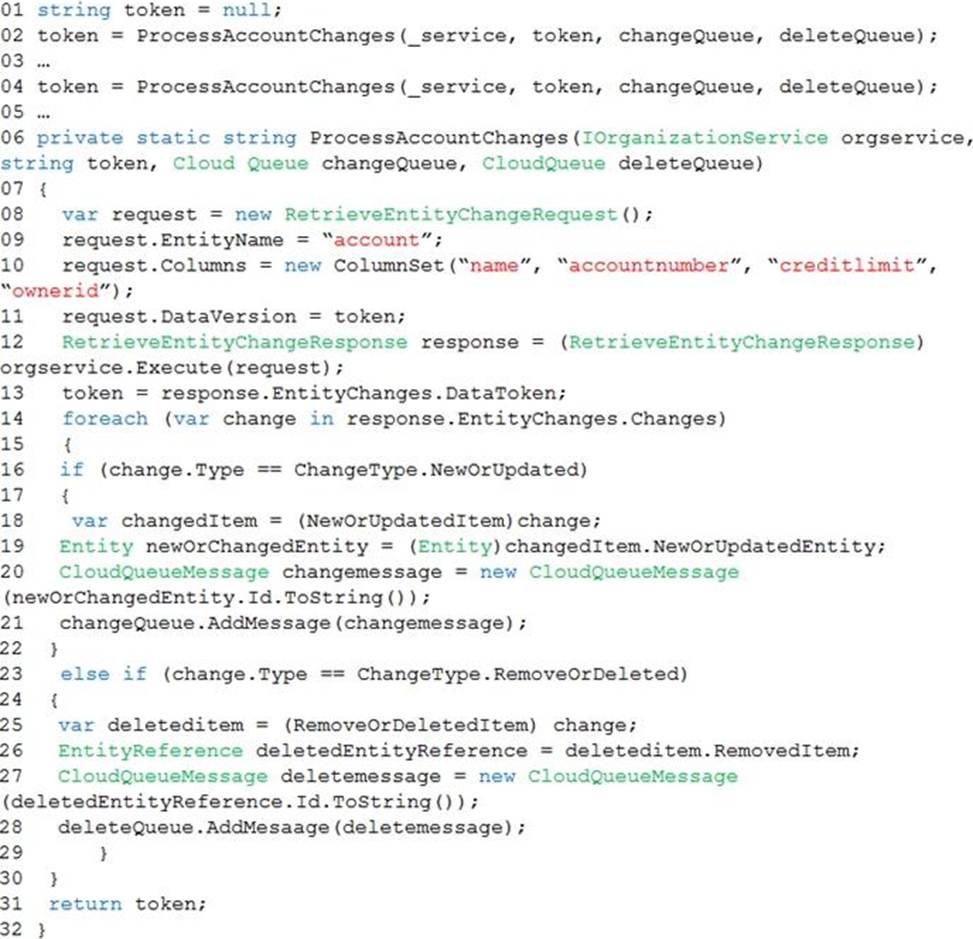
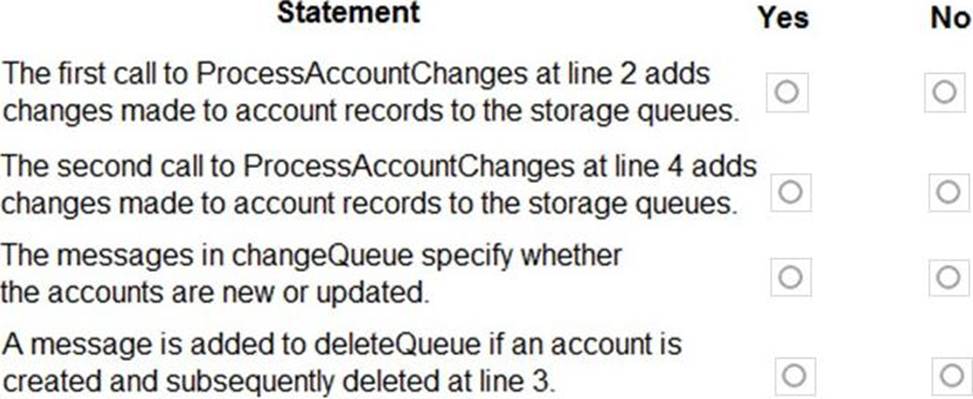
정답: 
Explanation:
Box 1: Yes
Box 2: Yes
Box 3: No
Either new/updated or removed/deleted.
Box 4: Yes

정답: 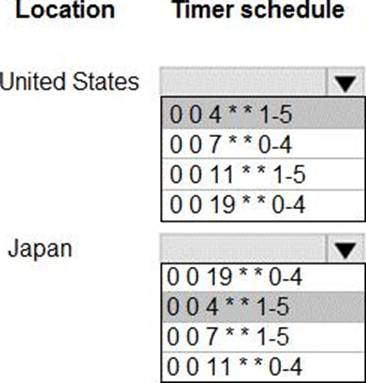
Explanation:
Box 1: 0 0 4 * * 1-5
Azure Functions uses the NCronTab library to interpret NCRONTAB expressions.
An NCRONTAB expression is similar to a CRON expression except that it includes an additional sixth field at the beginning to use for time precision in seconds:
{second} {minute} {hour} {day} {month} {day-of-week}
NCRONTAB time zones
The numbers in a CRON expression refer to a time and date, not a time span. For example, a 5 in the hour field refers to 5:00 AM, not every 5 hours.
The default time zone used with the CRON expressions is Coordinated Universal Time (UTC).
To have your CRON expression based on another time zone, create an app setting for your function app named WEBSITE_TIME_ZONE.
1-5 is weekdays
Box 2: 0 0 4 * * 1-5
Reference: https://docs.microsoft.com/en-us/azure/azure-functions/functions-bindings-timer?
정답:
Explanation:
Reference: https://docs.microsoft.com/en-us/powerapps/developer/common-data-service/walkthrough-register-app-azureactive-directory
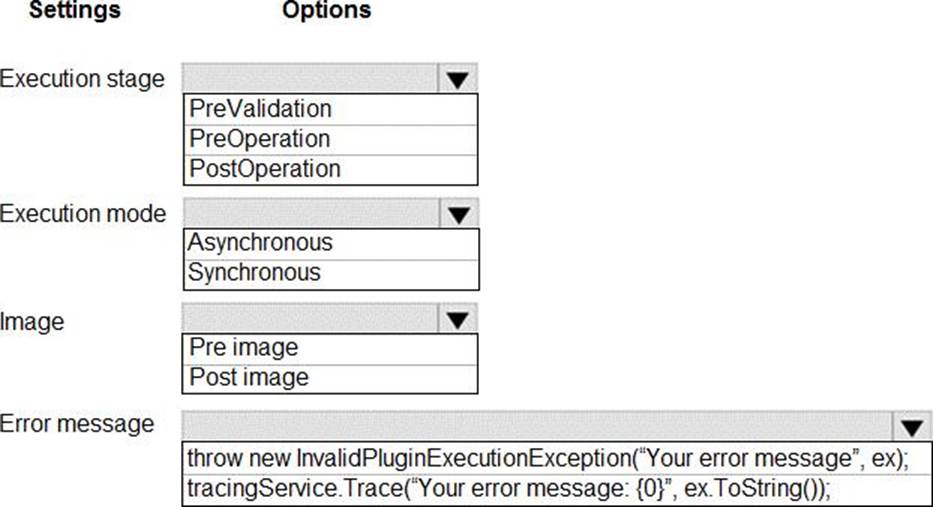
정답: 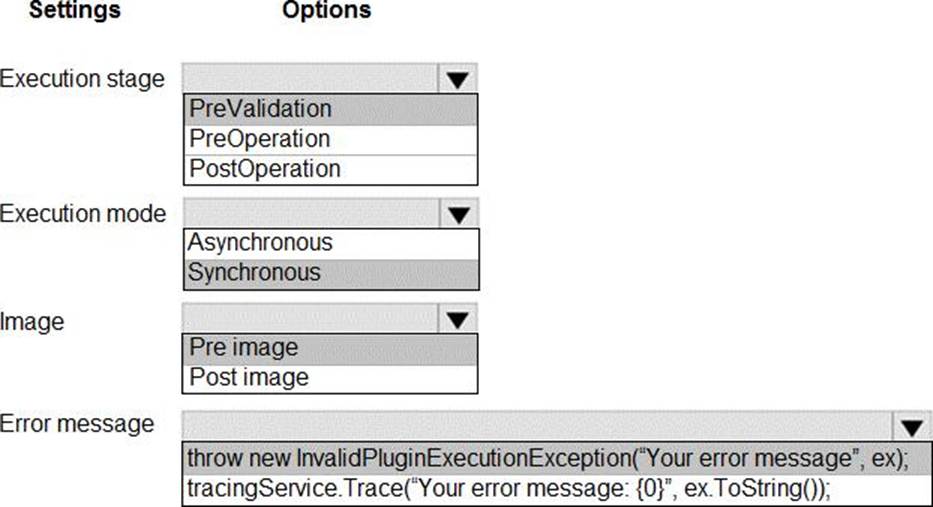
Explanation:
Box 1: PreValidation
PreValidation: For the initial operation, this stage will occur before the main system operation.
This provides an opportunity to include logic to cancel the operation before the database transaction.
Box 2: Synchronous
Ideally, you should only cancel operations using synchronous plug-ins registered in the PreValidation stage.
Box 3: Pre Image
Box 4: throw ..
When you throw an InvalidPluginExecutionException exception within a synchronous plug-in an error dialog with your message will be displayed to the user.
Reference:
https://docs.microsoft.com/en-us/powerapps/developer/common-data-service/event-framework
https://docs.microsoft.com/en-us/powerapps/developer/common-data-service/handle-exceptions
정답:
Explanation:
E: Before exporting an API, you must describe the API using an OpenAPI definition.
B: This OpenAPI definition contains information about what operations are available in an API and how the request and response data for the API should be structured. PowerApps and Microsoft Flow can create custom connectors for any OpenAPI 2.0 definition.
Reference: https://github.com/MicrosoftDocs/azure-docs/blob/master/articles/azure-functions/app-service-export-api-topowerapps-and-flow.md
정답:
Explanation:
C: You can create a custom connector using a OpenAPI definition file or a URL to OpenAPI definition.
B: On the Security page you get to choose how to authenticate to the API.

A: If you were to create a Custom Connector from scratch, then you whould have to study the API you have chosen and type in the URL manually here.
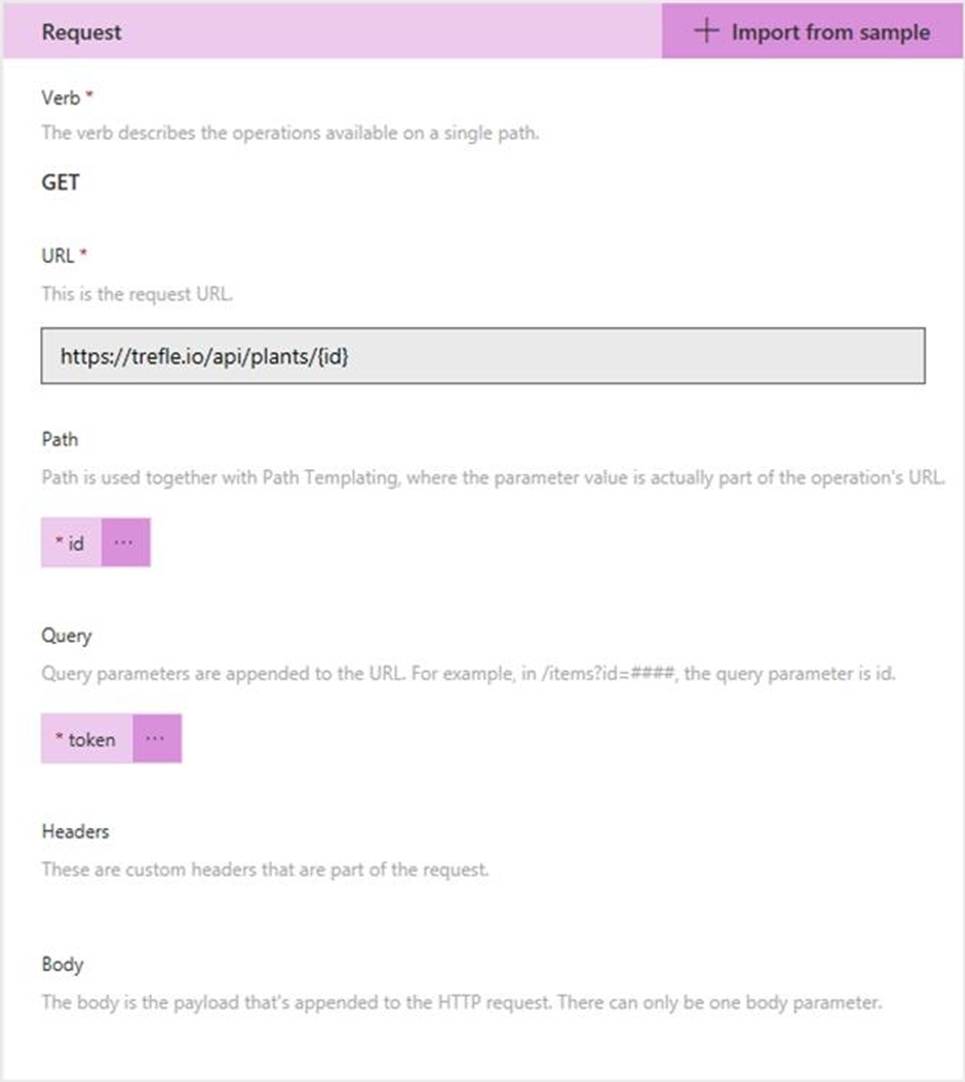
Reference: https://carinaclaesson.com/2019/09/06/setting-up-a-custom-connector-from-an-openapi-file-and-utilizing-it-in-powerapps-and-flow/
정답:
Explanation:
Visual representation of metadata can be useful, especially when you are trying to describe the relationship between entities in the system. You can use the Metadata Diagram sample code provided for Dynamics 365 Customer Engagement (on-premises) to generate the entity relationship diagrams.
You can create a diagram that shows a relationship for just one entity, or a complex diagram that includes dozens of related entities, including custom and system entities.
Reference: https://docs.microsoft.com/en-us/dynamics365/customerengagement/on-premises/developer/use-metadata-generate-entity-diagrams
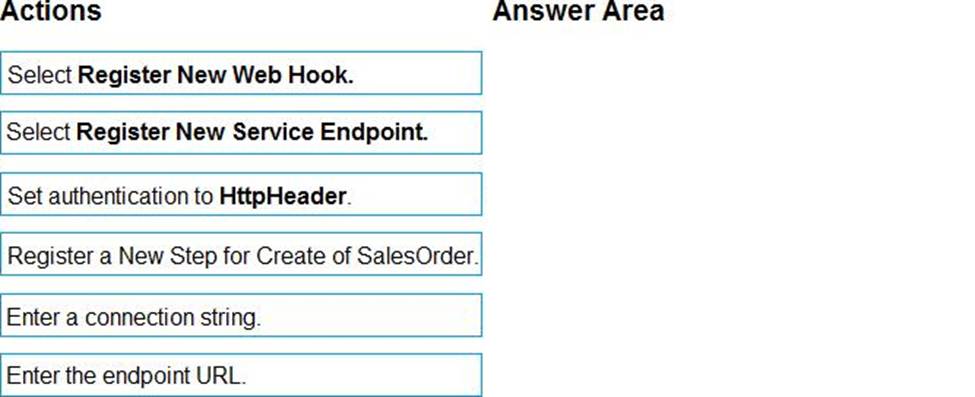
정답: 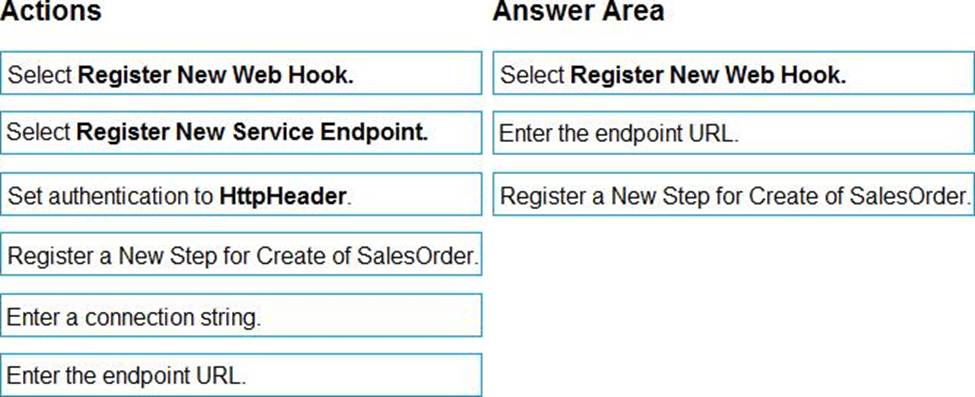
Explanation:
Step 1: SelectRegister New Web Hook.
Configure Dynamics 365 Sales to Call Your Webhook in Azure Functions
정답:
Explanation:
OAuth requires an identity provider for authentication. For Dataverse, the identity provider is Azure Active Directory (AAD). To authenticate with AAD using a Microsoft work or school account, use the Azure Active Directory Authentication Libraries (ADAL) or Microsoft Authentication Library (MSAL). https://docs.microsoft.com/en-us/powerapps/developer/data-platform/authenticate-oauth
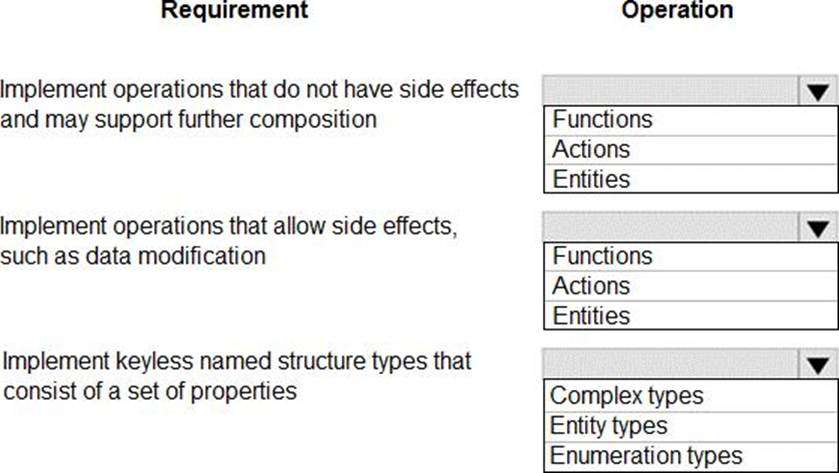
정답: 
Explanation:
Box 1: Functions
most functions and services that are stateless and do not have side effects.
Box 2: Actions
Actions can have side effects.
Box 3: Complex types
Reference: https://docs.microsoft.com/en-us/powerapps/developer/common-data-service/webapi/use-web-api-actions
정답:
Explanation:
C: The Web Form Step record contains a field named Custom JavaScript that can be used to store JavaScript code to allow you to extend or modify the form's visual display or function.
D: You can add custom Javascripts to Entity lists.
Reference:
https://docs.microsoft.com/en-us/powerapps/maker/portals/configure/add-custom-javascript
https://docs.microsoft.com/en-us/powerapps/maker/portals/configure/entity-lists#add-custom-javascript

정답: 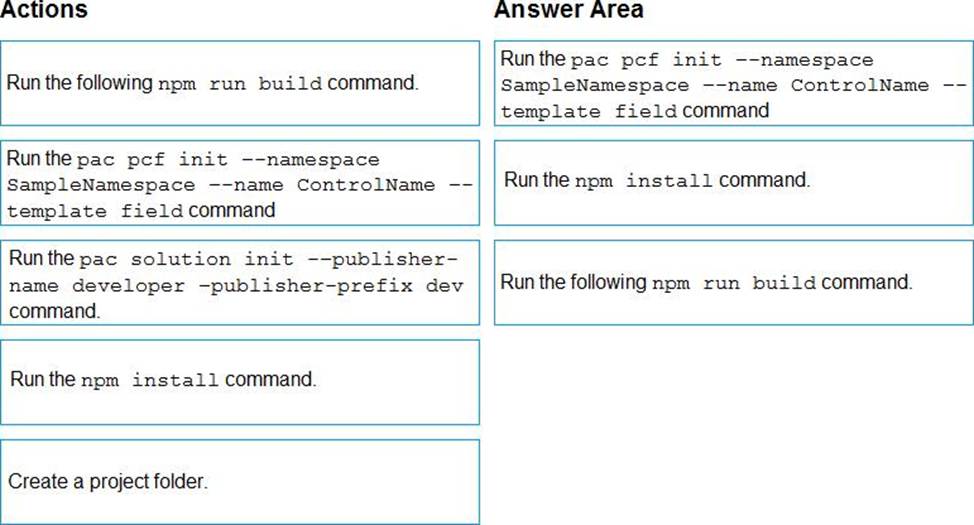
Explanation:
Step 1: Run pac pcf init Cnamespace ..
This is the first command which creates basic folder structure of PCF control project.
Run the following command to create the control.
The format of the control is:
pac pcf init Cnamespace <specify your namespace here> Cname <put component name here> C template <component type>
Step 2: Run the npm install command
Install Dependencies
Once ‘init’ sets up the basic folder, as a next step install all the PCF control dependencies using ‘npm
install’ command.
Example:

Now at this point, there is nothing we have actually created. However, the solution created contains sample PCF control code.
Step 3: Run the following np run build command
Build PCF Component.
Once you implement the PCF component, build the code for any syntax errors.
Syntax:
npm run build
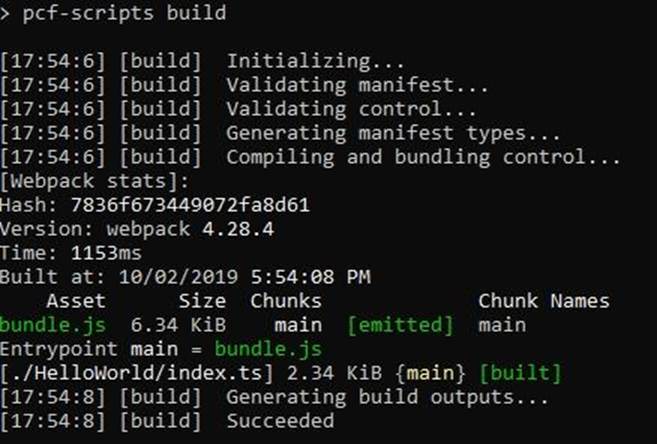
Reference:
https://rajeevpentyala.com/2020/03/21/power-apps-component-framework-pcf-demystify/
https://carldesouza.com/creating-a-custom-component-using-the-powerapps-component-framework/
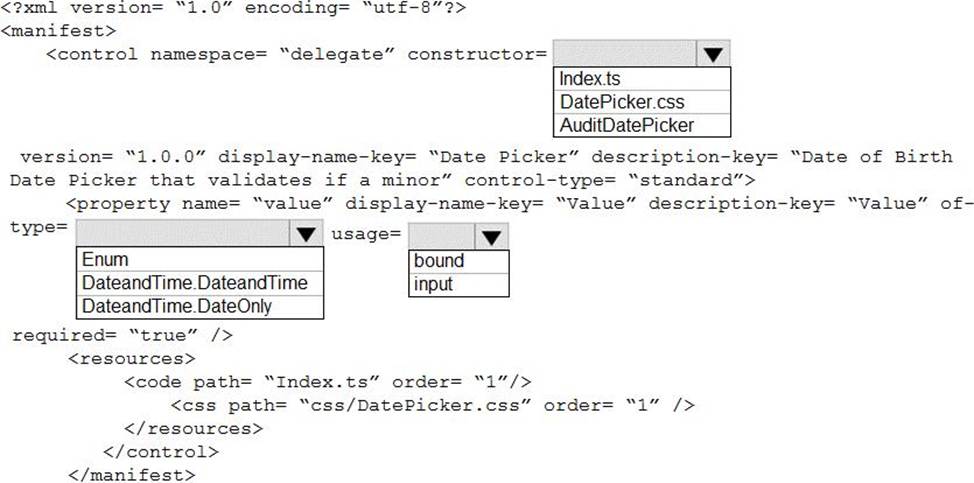
정답: 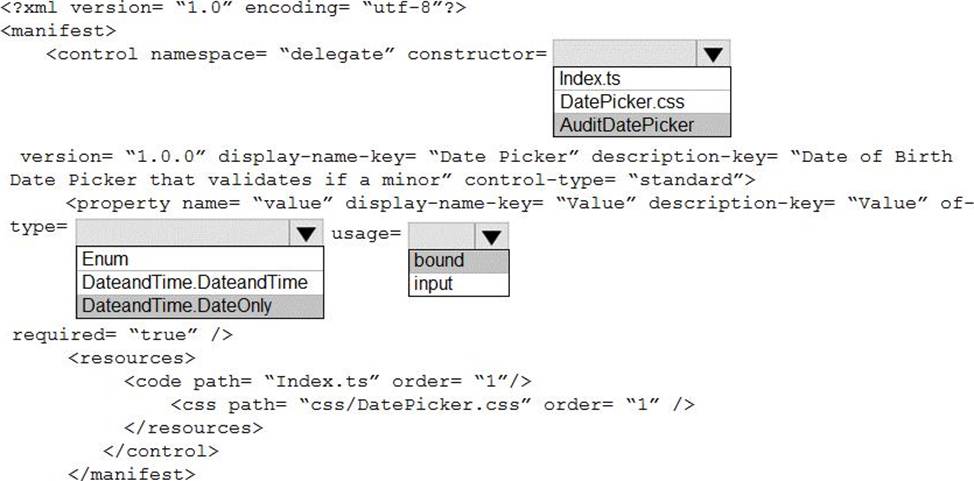
Explanation:
Box 1: AuditDatePicker
Constructor: Constructor of the code component.
Box 2: DateandTime.DateOnly
Box 3: bound
usage: Has two properties, bound and input. Bound properties are bound only to the value of the field. Input properties are either bound to a field or allow a static value.
Reference:
https://docs.microsoft.com/en-us/powerapps/developer/component-framework/manifest-schema-reference/manifest
https://docs.microsoft.com/en-us/powerapps/developer/component-framework/implementing-controls-using-typescript

정답: 
Explanation:
Box 1: CrmParameter
In addition to data values, you can retrieve client context information by using <CrmParameter>. You can use the following options as the value for the CrmParameter element: OrgName, OrgLcid, and UserLcid.
Box 2: UserLcid
userLCID is the language code of the current user.
Note: A locale is a set of user preference information related to the user's language. The locale determines how dates, times, currencies, and numbers are formatted, how items are alphabetically sorted, and how strings are compared. The locale identifier (LCID) is a 32-bit value that uniquely defines a locale.
Reference: https://docs.microsoft.com/en-us/dynamics365/customerengagement/on-premises/developer/customize-dev/pass-dynamics-365-data-page-parameter-ribbon-actions
정답:
Explanation:
When you include a workflow that you want to trigger on Stage Exit of a stage in your business process flow, and that stage is the last stage in the flow, the designer gives the impression that the workflow will be triggered when that stage is completed.
Reference: https://docs.microsoft.com/en-us/dynamics365/customerengagement/on-premises/customize/businessprocess-flows-overview